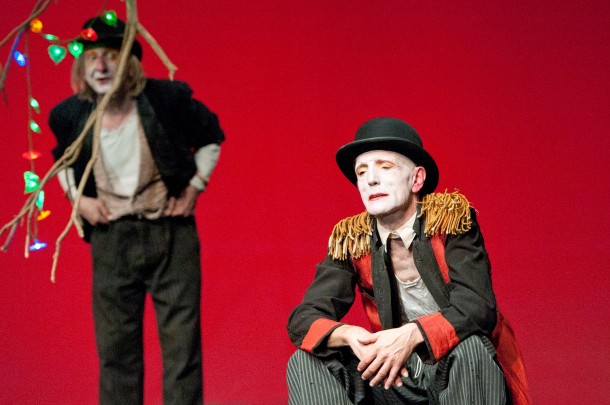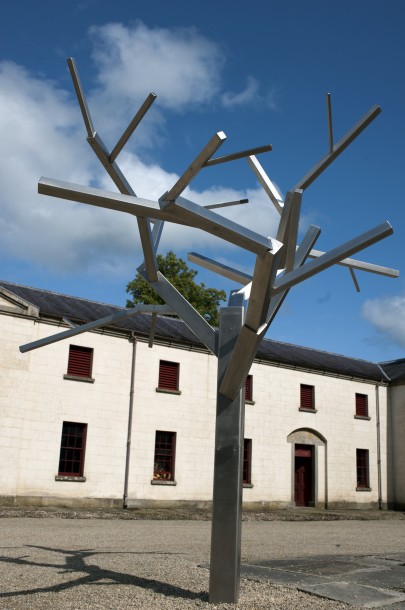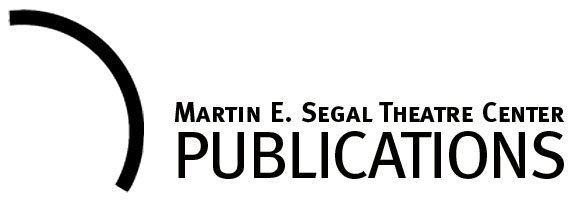In the Northwest of Northern Ireland in the county of Fermanagh lies the small island town of Enniskillen. On a hill above the town is Portora Royal, a school chartered under Queen Elizabeth I, which Samuel Beckett attended from 1920-23. It is one of the most prestigious schools in Ireland, the alma mater of Oscar Wilde and other luminaries. Two plaques on the austere façade attest to the attendance of Samuel Beckett and Oscar Wilde. Stony vestiges of ancient history dot the lush, green, watery landscape surrounding Enniskillen. Since 2012 Samuel Beckett is celebrated here with a yearly festival of unusual scope. Sean Doran, the Artistic Director and Founder, explains: “Our festival is multi-arts because Samuel Beckett engaged profoundly with the other arts, particularly classical music and visual arts. He integrated these art forms and their technique into his own dramas and prose. The Happy Days Festival celebrates Beckett as a total artist, not solely as a literary figure.” From the beginning, artists and scholars of international reputation have come together here to share their creative engagement with Samuel Beckett and his work. The festival has garnered the enthusiastic support of the local population, many of whom volunteer to chauffeur the artists to the various performance venues: Portora Royal, the Marble Arch Caves, various islands, a “secret” location, Enniskillen Castle, Castle Coole, and the Ardhowen Theatre. Local colleges host the lectures and conversations and various churches open their doors to the concerts. On a late night at Pat Bar, one could enjoy an intimate performance of Happy Days with Antoinette Cahill of Cavan Hecklers Theatre Company. Blakes of the Hollow, one of Enniskillen oldest and most famous pubs, was the site of afternoon voluntary sequential readings of Finnegans Wake in honor of Beckett literary friendship with James Joyce. On the last night of the festival, as a surprise, we were treated at Blakes to an undulating performance of “Anna Livia Plurabelle,” part of Finnegans Wake, by the great Irish actress, Olwen Fouere (also presented at BAM in September of 2014). Blakes was the post-performance, watering hole crowded with fellow artists, locals, and tourists for discussions over many pints of Guinness. Local businesses proudly advertized the events. Generous financial support has been granted by private donors and various governmental and commercial agencies of the Fermanagh district, Northern Ireland, Ireland, and Great Britain. Above all, the festival has enjoyed the active support of Samuel Beckett nephew, Edward Beckett, and the Beckett Estate.
An overview of the theatrical offerings this year demonstrates the international scope. There were two productions of Waiting for Godot: Theatre Nono from Marseilles presented the original French En Attendant Godot as a radical clownesque, while the New Yiddish Rep Yiddish production from New York remained faithful to Beckett specific directions. In Das Letzte Band, directed by Peter Stein, renowned German actor Klaus Maria Brandauer portrayed the title role of Krapp. All foreign language productions provided Beckett’s English text as supertitles. A premiere production of Catastrophe, which Beckett wrote in 1982 in honor of imprisoned Vaclav Havel, was directed by Fermanagh native, actor Adrian Dunbar. Words and Music, originally a radio play with music by Morton Feldman, was staged by Netia Jones. I Went Into the House But Did Not Enter, the third and last part of a composition by Heiner Goebbels, which he staged for and with the Hilliard Ensemble, was inspired by Beckett’s late, prose text, Worstward Ho. Roaratorio, first conceived in 1979 by John Cage for voice, tape, and musicians as an “Irish Circus on Finnegans Wake” and choreographed by Merce Cunningham in 1983, revived by the Merce Cunningham Dance Company in 2010, was performed in excerpts in the Marble Arch Caves by the Dylan Quinn Dance Theatre with installations produced by SARC Queen University Belfast.
Two Waiting for Godot productions, at the same time, in the same place, provided an opportunity to see the range of artistic possibility, as well as the human dimension of this modern masterpiece. Beckett’s work is a profound expression of fundamental, real human experience, but it is structured and notated like a piece of music. It presents the poetry of spoken language, the fluid imagery of bodies in motion and at rest, of light and shadow—it distills all emotion and thought into the vessel of the actor. And yet the play allows for a wide range of aesthetic styles, as could be seen by the extreme differences in approach between Theatre Nono and New Yiddish Rep. Theatre Nono En Attendant Godot filled the large space of the Ardhowen Theatre with a cyclorama that was lit in changing primary colors—Rothko-red sticks in my memory. In the center, a delicate, multi-branched tree was suspended upside down, bedecked in act 2 with one string of small, colored Christmas lights. Stage left was bordered by a tall wooden wall. Black pebbles derived from old tires covered the entire playing area. A short actor played Vladimir, while Estragon was an extremely thin, tall actor (Christian Mazzuchini and Noel Verges), Pozzo (Serge Noyelle) was presented as a somewhat demented, cruel, circus director in shorts and a wig with long reddish hair. He kept on his leash an extremely agile, fat, tall, young Lucky (Gregori Miege) who did a terrifying St. Vitus dance and delivered his monologue in unintelligible spastic spurts—an actor’s feat of endurance. The costumes appeared like an assortment of random pieces from a costume shop. Only the bowler hats bore the classical Beckett imprint. The visual aspects of this production seemed to me a choice of diametric opposition to Beckett’s aesthetic demands and stage directions by the director/dramaturg, Marion Coutris, and the designer, Serge Noyelle. At the end of act 2, Didi and Gogo tiptoed off the stage—a clear disregard of Beckett’s instruction that they stay by the tree with the final words “Shall we go? Yes, let’s go. (They do not move).”
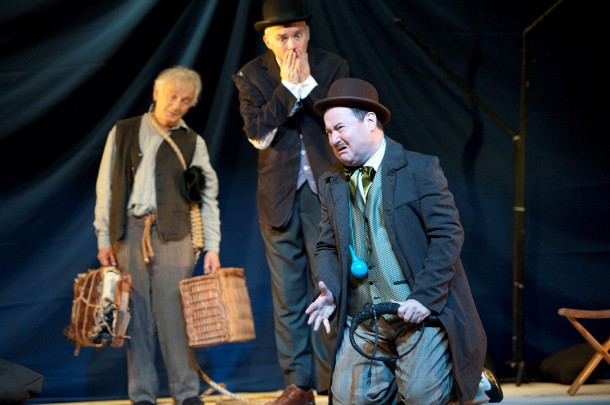
Vartn Af Godot, New Yiddish Rep, New York. Estragon: David Mandelbaum, Vladimir: Shane Baker, Pozzo: Allen Lewis Rickman, Lucky: Rafael Goldwaser. Photo: Cordula Treml
The Yiddish Vartn Af Godot was performed on the small stage at Portora Royal. This production kept to Beckett’s minimalist aesthetic and paid homage to the historical context of post-Holocaust and post-World War II, under whose shadow Beckett conceived and wrote the play in late 1948. The director, Moshe Yassur, a survivor of the Holocaust whose mother tongue is Yiddish, felt that presenting the play for the first time in Yiddish demanded a particular approach, while remaining absolutely faithful to Beckett’s text and directions. Vladimir and Estragon were therefore not treated as tramps or clowns but as homeless survivors of a catastrophe who are wandering through a no-man land. The stage functions as a metaphor but also literally as the place where the actors present the activities of the characters. George Xenos designed a set that emphasized this theatrical functionality: a sand-color, carpeted floor, a tree made of industrial pipes, black sandbags for the small hillock on which Gogo and Didi sit, upstage, a sky-blue cloth tied up by ropes, an opaque globe, lit from the inside and lowered on a visible wire, served as moon. Lighting designer Greg MacPherson supported the poetry, as well the theatricality, with a play of shadows and some visible instruments. The Yiddish translation by Shane Baker, who played Vladimir, emulates Beckett’s cadences, while allowing the actors to imbue the characters with a specific Jewish geste or cultural body language. Differences in Yiddish dialects, such as Litvak and Galician, underscored the physical as well as the vocal contrasts between the more refined Didi and the more earthy, cantankerous Gogo, played by David Mandelbaum (Artistic Director of New Yiddish Rep). Rafael Goldwaser, a Yiddish actor from Strasbourg trained in mime, was a delicate, wiry, small Lucky who presented the famous monologue like a rabbinical homily gone awry, so that the text about the fire that will blast “hell to heaven” suddenly gained a resonance rarely experienced in the more conventional, nonsensical renderings of Lucky’s speech. The quiet exchange of Didi and Gogo about the “dead voices” was received by audiences with palpable silence. Alan Lewis Rickman played Pozzo in the first act with superb comic timing, like a cross between Oliver Hardy and W.C. Fields; in act 2, he conveyed with irate pathos the tragic dimension of his physical disintegration.
Das Letzte Band was an actor’s feat of concentration. Klaus Maria Brandauer was seated in a dilapidated armchair behind a metal desk, with the tape recorder in intimate proximity. A sharply delineated circle of cold, white light sucked all the warmth out of the scene. A bulbous nose dominated Krapp’s face, framed in a halo of unkempt, curly, grey hair; in fact, he looked like a rather hideous old clown, whose extremely pointed white shoes seemed like a worn-out fashion prop of a 1970s gigolo. The posture of his shapeless, neglected body resembled the much-adored banana. After a long, initial silence, his voice softly exhales, “SPUUUUULE” [spooool] in an old man’s soprano voice. There were several memorable aspects of Brandauer’s performance. The extreme ritardando of movement and speech in the beginning—I think a Peter Stein directorial trademark—eventually exploded into a staccato of self-deprecation. Krapp’s melodious, deep voice on the tape as a young man provided a musical contrast to his thin, high voice as the old man who comments on the young man. The gentle peeling of the banana was contrasted with the furious unspooling and dispatching of a tape. The final image: as he rewinds for the last time the tape in which he recounts the love-making on the boat, he crawls onto the table and lies prone, embracing the tape recorder, giving himself over to that moment of lost love and life. The moment was “all poetry,” as Beckett would have said.
Catastrophe, a revelation of political theatre, was directed by Adrian Dunbar, the artistic consultant to the festival and a fine actor himself.* The first surprise was a trip on a rickety bus that took the audience from Enniskillen Castle for over half an hour through the countryside to an undisclosed location that the audience was to keep an absolute secret. After some hair-raising encounters on narrow, hilly roads, we came to an abandoned, old-stone chapel next to a graveyard. We sat down in the pews, inhaled the musty smell of meter-thick stone walls, and gazed on a scantily dressed immobile man, the Protagonist (the dancer Dylan Quinn). The door clanked shut. The Director (Frank McCusker), in a fur cap and a thick coat comes down the aisle, sits in the arm chair to the side. With him is a woman in a white coat, The Assistant (Orla Charlton) with a notepad. He gives her directions about what is to be done with the immobile figure—they sound like a theatre director’s notes until it sinks in that this manipulation amounts to torture and a total negation of the humanity of the man who is thus exposed and at the mercy of the Director. The Assistant does nothing but comply with the orders given. There is no physical violence, but the meaning is clear. It suddenly occurred to me that being taken to a secret location corresponds exactly to the methods of totalitarian terror—people disappeared and nobody knew where and what happened to them. It was a brilliant psychological extension of this singularly political play by Beckett.
![Words and Music. Music: Crash Ensemble, Croak: Ian McElhinney [in the white box]. Photo credit: Cordula Treml.](http://europeanstages.org/files/2014/11/Words_and_Music2_©_Cordula_Treml_DSC1515_jpg-610x405.jpg)
Words and Music. Music: Crash Ensemble, Croak: Ian McElhinney [in the white box]. Photo: Cordula Treml
I Went Into the House But Did Not Enter by Heiner Goebbels was perhaps the most elaborate production in terms of stage setting. An enormous version of a hotel bedroom with a conventional décor of patterned wallpaper on tall walls enclosed the Ardhowen playing space: upstage, a tall window with a blowing, white, voile curtain through which streamed light; stage left, a large, double bed with night tables and small, lit lamps; upstage right, a dressing table with mirror, next to it some elegant leather suitcases; a couple of easy chairs completed the tasteful but impersonal setting. Originally conceived for the Hilliard Ensemble and premiered at the Edinburgh International Festival in 2007, the Happy Days Festival presented this farewell performance of the Hilliard Ensemble. Five mature, elegant men, dressed in impeccable suits, entered and left the room, rested on the bed, looked out the window, and intermingled seemingly at random, all the time singing Beckett’s words in polyphony, on a single note, frequently repeating the most famous line of Worstward Ho: “Ever tried. Ever failed. No matter. Try again. Fail again. Fail better.” There was a quiet beauty about the whole performance that achieved a near trance-like effect.
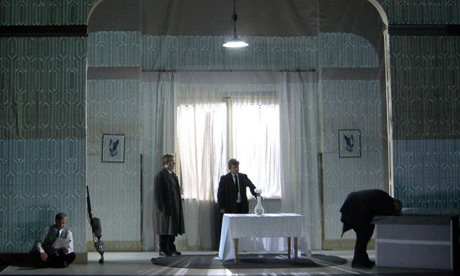
I Went into the House but Did Not Enter, Théâtre de Vidy-Lausanne, The Hilliard Ensemble. Photo: Cordula Treml
A plethora of musical offerings related to Beckett’s affinity for music. Gavin Bryars with the Gavin Bryars Ensemble presented for the first time a selection of Beckett poetry, composed by Gavin Bryars, in the intimate setting of the Enniskillen Presbyterian Church. Arnold Schoenberg’s Verklärte Nacht was presented as a combination of live chamber music and Netia James’ visual installation. A Beckett Schubertiade included a morning performance of the haunting Trio in E Flat in the Methodist Church, The Trout Quintet on another morning in St. Macartin’s Cathedral, where in the evening one could listen to Death and the Maiden, which Beckett included in his 1957 radio play, All That Fall. The Festival Closing Concert was a glorious rendering of the song cycle, Winterreise, with baritone Sir John Tomlinson, accompanied on the piano by the ubiquitous music director of the festival, Julius Drake. In addition, there were other musical delicacies: Dmitri Shostakovich’s Piano Trio No. 2, played by the Phoenix Trio and his String Quartet No. 8, played by the Meccorre Quartet, two works that incorporate Jewish motifs and were composed in response to Stalin’s anti-Jewish program after WWII. An afternoon concert featured Shostakovich’s Jewish Folk Poetry Song Cycle with two superb singers, mezzo Ruby Philogene and soprano Lea Trommenschlager, accompanied by Mr. Drake. Of particular interest among the “Precious Little Afternoon Concerts” that paid homage to Beckett’s life in France was Ravel’s cycle Chansons Madecasses with mezzo Ruby Philogene, Mr. Drake on the piano, a member of the Meccore Quartet playing cello, and Edward Beckett playing the flute. One might say music was all over Enniskillen.
Samuel Beckett cultivated close, often life-long friendships with a number of visual artists; he also published interviews with and articles about artists. For example, the sculptor Alberto Giacometti designed a Godot tree; during the war, while in hiding in Roussillon, Beckett played chess with the painter Henri Hayden; Avigdor Arikha made some lovely sketches of Beckett. Buster Keaton’s particular style of deadpan comedy was immortalized in Film, a film created by Beckett. As part of the visual festival exhibitions, the short film, Deadpan, (1997) was played as a loop in which Steve McQueen stages himself in the famous Buster Keaton scene of a house collapsing around a figure who remains unhurt since he stands exactly where a window is missing. Derek Jarman’s 8 mm film Waiting for Waiting for Godot (1983) took up the Waiting for Godot theme that was central to this year’s festival. The sculptor Antony Gormley built a Godot tree commissioned by the festival for a future Australian Aborigine and Irish production of Waiting for Godot. Gormley explained: “The tree I have designed as a stage element…accepts its status as an image, and therefore its artificiality…It is almost not a ‘tree’ at all but an aerial or mast, which makes the same connection between sky and earth. It becomes about transmission or extraction rather than a romantic image of nature.” A delightful, thirty-two piece, large chess set by the sculptor Alan Milligan was set up in the courtyard of medieval Enniskillen Castle. The figures were based on the props and characters of Beckett’s works.
A series of lectures by noted scholars took up subjects related to Beckett and his work: Mark Nixon spoke on Beckett and WWII; Terry Eagleton looked at “political Beckett”; Declan Kiberd considered Beckett after Joyce. Other speakers and discussions took up various themes in Beckett’s work. Germaine Greer offered a view on the future of the novel after Beckett. The great pianist Alfred Brendel, in discussion with Michael Berkeley, focused on the role of silence in music and in performance, which relates to Beckett’s use of silence. Discussions by directors and performers about their approaches to Beckett rounded out the diverse offerings for a view inside the creative process.
All events were well attended by festival participants as well as locals and visitors. For ten days, one shared a sense of discovery, made new friends, exchanged ideas and email addresses, learned about the vagaries and tragedies of Fermanagh history, where 500 years ago happened yesterday, while the time of the more recent “Troubles” seemed largely overcome. In this magical place, the festival honors Samuel Beckett as a total artist whose life and works embodied the rich fabric of human experience in all its tragedy, pathos, and comedy—it is “all poetry.”
, Ph.D. Comp. Lit., has worked as a teacher, translator, and freelance dramaturg. Born and raised in Germany and trained in all aspects of
theatre arts, she has a high respect for the art in all its complexity from front to backstage, from spoken language to the language of the body. Her latest involvement has been as dramaturg for the New Yiddish Rep/Castillo Theatre premiere production in Yiddish of Waiting for Godot in New York. A theatrical highlight was as translator and dramaturg for The Living Theatre production of Else Lasker-Schüler’s IANDI on Avenue C. She is currently translating Judith Malina’s book The Piscator Notebook (Routledge, 2012) into German.
European Stages, vol. 3, no. 1 (Fall 2014)
Editorial Board:
Marvin Carlson, Senior Editor, Founder
Krystyna Illakowicz, Co-Editor
Editorial Staff:
Elizabeth Hickman, Managing Editor
Bhargav Rani, Editorial Assistant
Advisory Board:
Joshua Abrams
Christopher Balme
Maria Delgado
Allen Kuharsky
Jennifer Parker-Starbuck
Magda Romańska
Laurence Senelick
Daniele Vianello
Phyllis Zatlin
Table of Contents:
• The 68th Avignon Festival 2014, July 4 to 27: Protests and Performances by Philippa Wehle
• The Avignon Fringe Festival 2014 by Manuel García Martinez
• The Reality Bites of New Bulgarian Theatre by Dessy Gavroliva
• Happy Days: Enniskillen International Beckett Festival 2014, July 31-August 11 by Beate Hein Bennett
• Flemish Theatrical Exceptionalism Mostly Glimmers, Sometimes Wavers by David Willinger
• Shouting at the Devil (and Everyone Else): Yaël Farber’s Production of The Crucible at The Old Vic by Erik Abbott
• Mladinsko Theatre and Oliver Frljić’s Damned Be the Traitor of His Homeland! (Sibiu International Theatre Festival, Romania, 2014) by Ilinca Todoruţ
• Barcelona Theatre (2013): Responding to Spain’s Crisis by Maria Delgado
• Report from Madrid by Duncan Wheeler
• Irish Colonial History on the Hungarian Stage by Mária Kurdi
• Fantastic Realities: Actors as Puppets and Puppets as Actors by Roy Kift
Martin E. Segal Theatre Center:
Frank Hentschker, Executive Director
Marvin Carlson, Director of Publications
Rebecca Sheahan, Managing Director
©2014 by Martin E. Segal Theatre Center
The Graduate Center CUNY Graduate Center
365 Fifth Avenue
New York NY 10016

